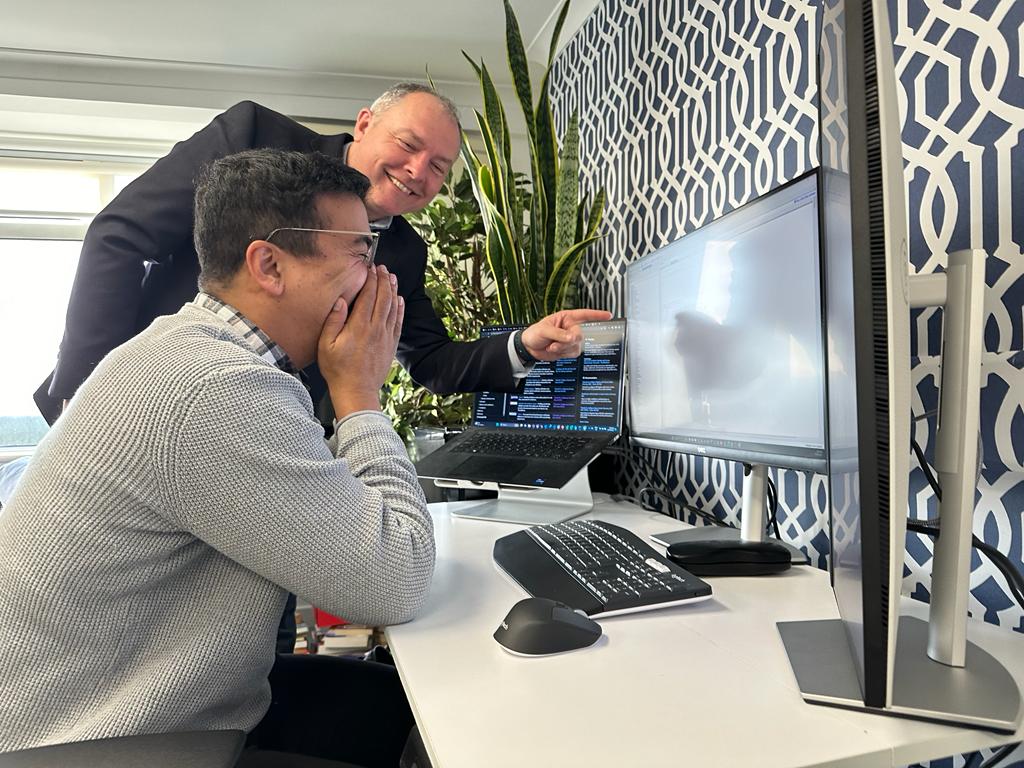Next up in our day in the life of blog series is Isaac Hart. He’s been a part of the team for one and-a-half years (since August 2021) and really enjoys the problem-solving aspect of his job.
Isaac works across all of the projects we deliver and spends a lot of his time focused on database and AI-related programming projects.
Q. What does your job involve?
Working on a wide range of tasks that include data migration. For these tasks, I refine the contents of client databases into formats that can be transferred to new systems, particularly Dynamics CRM.
For the AI implementation-orientated tasks, I create schema for input data and adjust the modelling software until the output matches our expectations. In between all of those tasks, you’ll also find me adding new functionality to our internal systems. This enables us to not just improve how we track tasks and synchronise our own data, but improve the range of Dynamics features we offer to our clients.
Q. What are you currently working on?
I’m currently focused on a Dynamics integration that incorporates Azure Form Recogniser. It determines whether an incoming email has an invoice attached and uploads the file to a form recogniser to extract the details.
Finally, it then creates an invoice record within Dynamics CRM that contains information, including client details, billing addresses and the amount due. By using this integration, our clients have an overview of both historic and outstanding invoices. Tracking outstanding tasks within a shared workspace helps make sure they remain visible to everybody. Meanwhile, the general shift towards a single workspace helps reduce data loss.
Q. What’s the first thing you do every day?
Open my notes from the day before and pick up where I left off.
Q. How do you plan your work/time?
I tend to always keep an eye on what’s happening a few days ahead, which enables me to keep tabs on tasks that may have been completed early or are overdue. We have a central system for managing our tasks and time, which involves creating DevOps tickets that contain an outline of the task and a time estimate. I methodically work my way through the list of tickets. I also make rough notes as I work through the tasks and upload them to the system, so everybody knows what I’ve progressed and am working on, as well as the solution that’s been/being implemented.
Q. How much of your work is client-facing?
Most of it. I’m in regular contact with our clients via email, telephone and face-to-face.
Q. What do you enjoy the most about your job?
The problem-solving aspect of it. Inevitably, there are always complications in relation to the initial task outlines. However, the overall process of identifying what the issue is and how to work around it is extremely fulfilling.
Q. Provide us with an example of a problem you enjoyed solving
We developed an onboarding portal for a client earlier this year and discovered there was a page that wasn’t displaying properly once all of the data had been added in.
After looking into the issue, I discovered a staggered series of small sequencing issues was preventing the page from automatically displaying. I resolved the problem by working in the back-end of the system, which involved updating when the data registered on the portal. While it was a relatively minor problem, it was enjoyable to resolve because it soon transpired that composite small bugs were causing wider issues that were inadvertently fixed along the way.
Q. What’s a common misconception about your work?
That learning to code is extremely complex. Because of the range of learning resources that are now available online, and how structured most languages are, it’s now possible to pick up the basics relatively quickly and write your own programs within a few weeks.
Q. How do you keep on top of the latest industry developments?
I’m really interested in AI outside of work and have a few models that I’ve developed and am continuously experimenting with. As part of this, I’m always hearing about new releases and/or products and looking how to incorporate them.
Q. When was the last time you completed some training and what was it?
Last week, I spent half a day reading up about Microsoft’s AI-900 certification. It details the different AI services that can be interacted with on Azure.
Q. What’s the next step for you career progression-wise?
Training a custom AI model for client use. While I’ve been able to develop programs that interact directly with established AI models, they are often designed around specific use cases and can be limited in scope. Being able to train and develop our own model would enable us to work outside of these specific use cases and significantly broaden the range of applications we’re able to create.
Q. Describe your job in one word.
Innovative.
We hope you’ve found this blog interesting. For further insight about who we are and our capabilities, take a look at: https://www.xrm.je/why-xrm/

Written By: Simon Jackson
With over two decades of hands-on experience with Microsoft Dynamics and an impressive 25-year track record in coding and business solutions consultancy, Simon brings a unique blend of expertise to his clients. His deep-rooted knowledge in Microsoft Technolgies, coupled with his extensive coding experience, equips him with a competitive edge in delivering effective and efficient solutions. Simon's distinguished career has largely been dedicated to serving clients within the financial sector and the burgeoning fintech industry. His client base is diverse and expansive, ranging from startups to established corporations, all of which have benefited from his invaluable insights and solutions. This demand for his expertise is a testament to his adeptness and reliability in the field. Simon's expertise extends beyond Dynamics solutions. He possesses a profound understanding of databases and software integrations, AI, security architectures, and the deployment of multi-country models. His proficiency in these areas ensures he can navigate complex technical landscapes and deliver tailored solutions that align with clients' strategic goals. His proven ability to integrate complex systems while ensuring robust security models stands as a testament to his adaptability and technical prowess.


